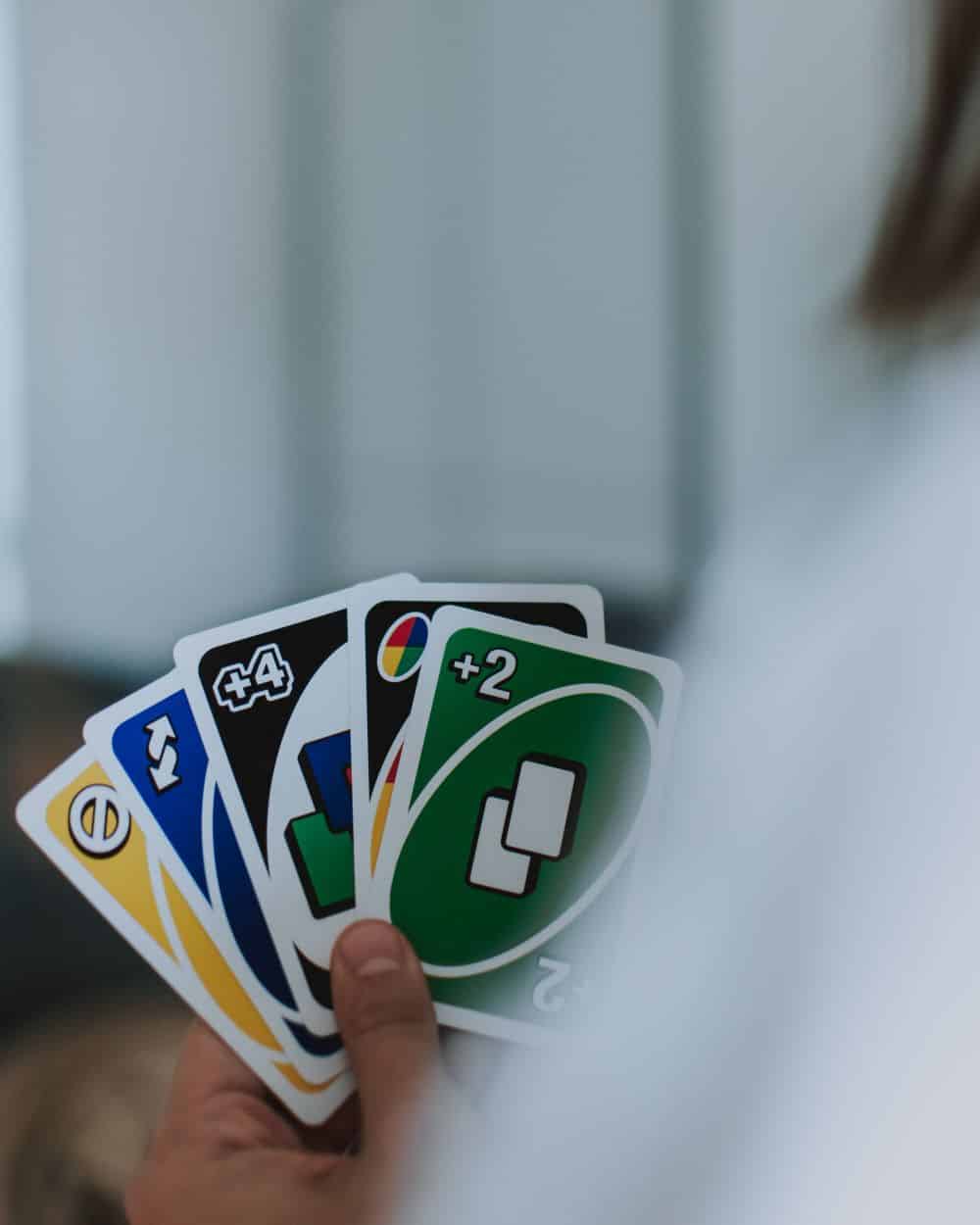If you’re a parent that doesn’t want their child stuck in front of a flickering screen when the weather is bad – don’t worry we’ve got you covered. Not only can you get them away from technology, but these card games for kids let them practice some math skills without even realizing it.
View in gallery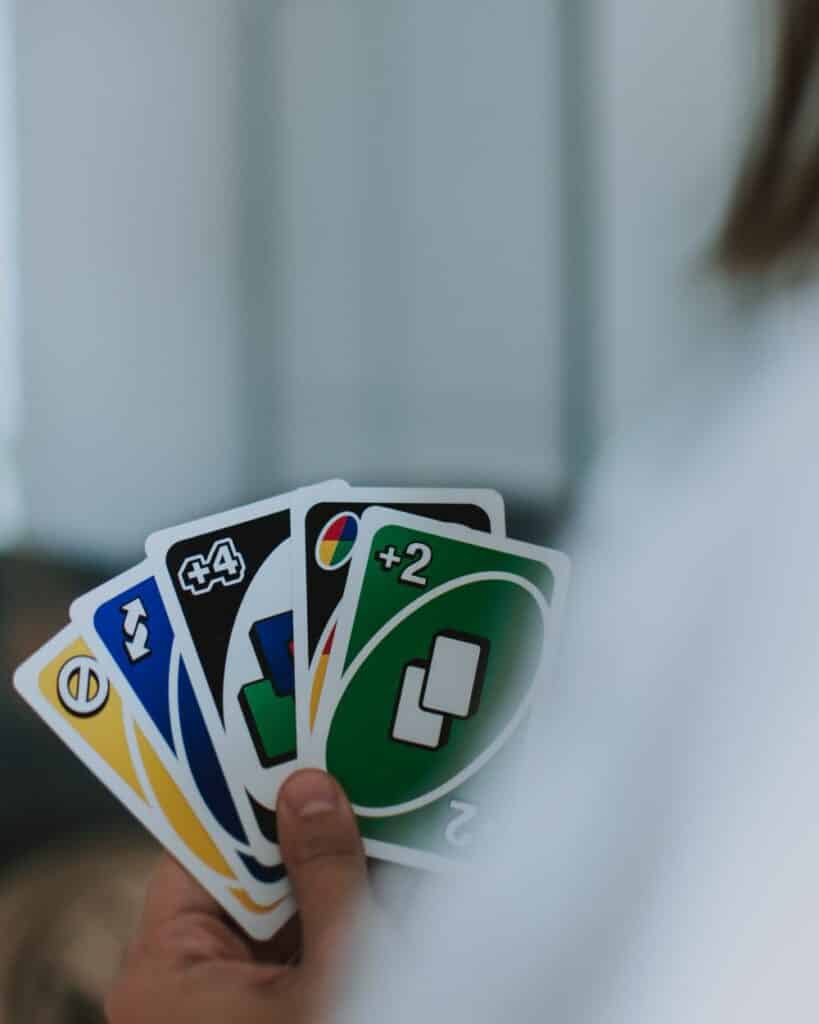
Playing card games together with friends and family is a fond memory shared by many, so why not introduce your kids to the wide range of entertainment they can have from a standard deck of cards.
Whether you’re looking to entertain your kids on a rainy day or just introduce them to some classic card games, they construct a great opportunity to spend quality time together whilst also providing an educational experience for all age ranges.
We have gathered some of the best age-appropriate, educational, and fun card games for kids to provide endless enjoyment no matter how many players and ages are involved.
From memory games to card constructions, the game play from these basic games for kids will become a family favorite in no time!
2 Card Memory Games
View in gallery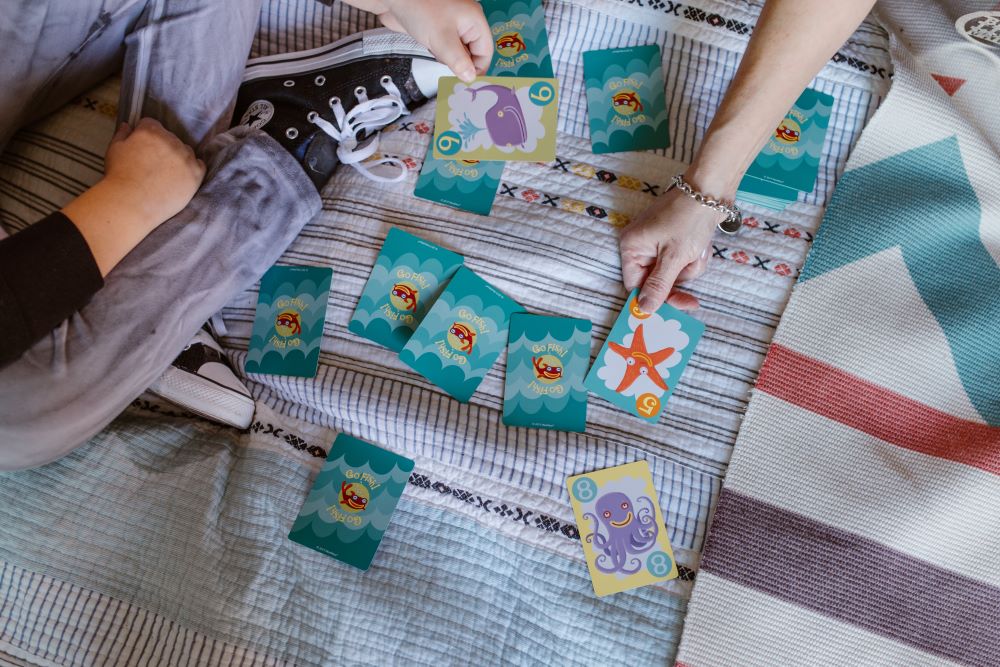
Memory card games for kids are highly adaptable and implementing the use of playing cards can provide a fantastic learning opportunity for all ages. Memory games create an opportunity for easy games and are often more suited to younger kids who may have a harder time grasping overly mathematical games that involve addition or subtraction.
You can create a variation in memory games by choosing to focus on the colors, pictures, or the suits on your playing cards.
1) Snap
- Ages 3-6
- Up to Eight Players
Snap can be played with any traditional playing cards or a themed set designed to create easy card games for younger children.
You can introduce the concept of numbers, colors, and suits to your child all depending on their individual capabilities in this easy card game. Themed cards that are tailored to their interests can make Snap even more fun.
This educational method is a great basic game to introduce all the information that a card game requires.
It is important you establish an appointed referee to help make the decisions if any disagreements should arise during the game.
How to Play Snap:
- Deal out the cards and make sure every player card’s face down.
- The first player can now turn over their top card and create a starter pile at the center of the table.
- The next player can now turn over their card and add it to the draw pile.
- Play continues clockwise to each player until two cards match from the draw pile and the first player to shout “Snap” wins the cards from the middle.
- If a player runs out of cards, they then lose the game.
2) Pairs
- Kids of All Ages
- Up to Six Players
This game comes under several names such as Concentration, Matching Pairs or Match Up, but all of them have the same gameplay.
This fun card game for kids is highly adaptable, making it suitable for a large age range. Playing Pairs can help to work on children’s memory, patience and provide an educational experience with the whole family.
You can use any deck of cards, and with a standard deck of 52 cards you can lay them down into 4 rows of 13 cards each, or you can include the two jokers for six rows of nine cards.
You can alter the rules of what qualifies as a match to suit the age and abilities of your child from rank, color, suit, and numbers. The game can also be made into physical activity by laying one card out across a room to encourage movement and fun in this card game.
The great part of this game is as each player takes their turn, you get to see the cards face up and have to remember the locations in order to make a match on your next round.
How to Play Pairs
- One person can be responsible for laying out all the cards and making sure that no two same cards are in close proximity.
- In turn, each player can choose two cards to turn face up and see if they match in whichever way you choose (color, suit, number, etc).
- If they are the same rank this player collects the winning pair and plays again. If they are not the same rank the player can place these cards face down again. The turn then passes to the player on the left of the dealer.
- The game continues until the last pair has been matched and the player with the most cards wins.
2 Math Card Games
View in gallery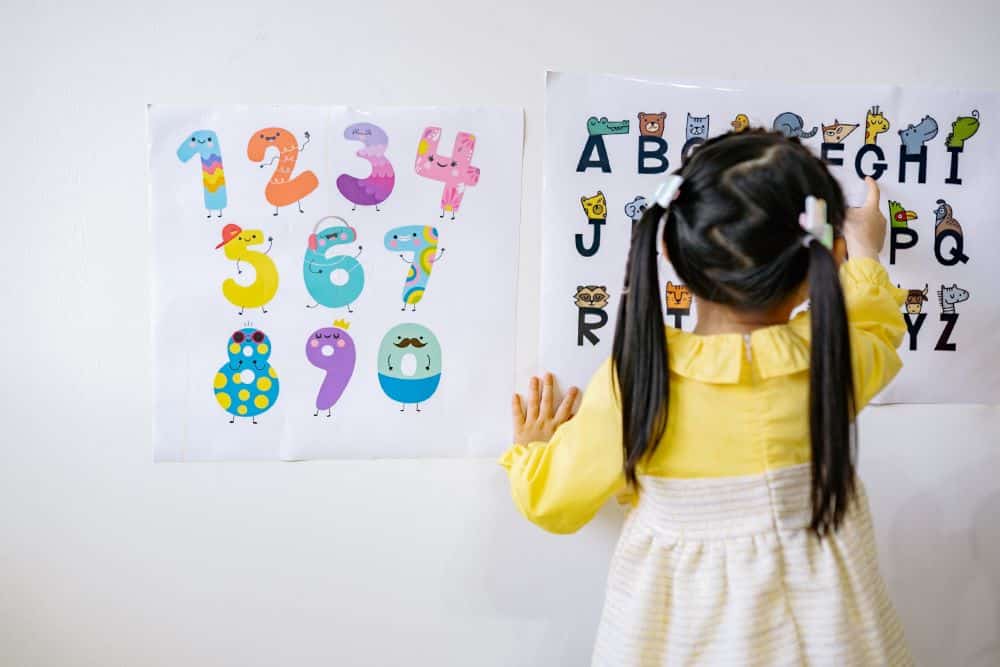
Math is often an unloved topic in kids’ education, but people of all ages love to play games so why not introduce some beneficial learning activities through card games for kids?
Engaging your child in mathematical play can encourage them to explore number combinations, patterns, mathematical concepts and can help provide further understanding and reasoning through play.
When a game is played repeatedly, it can help to strengthen strategic thinking in your child’s brain and create the potential to unlock better numeracy skills. Here are some of our favorite math educational card games for kids for you to try at home!
1) Ace Wars
- Ages 7+
- Two to Eight Players
We recommend this game for children aged 7 and above, but you could adapt the game for younger children by slightly altering the rules to make the game easier. Ace Wars is a great way to encourage competitive children to sharpen their quick addition skills.
The common rule for this game is that all face cards are worth the same value of 10 points, and the ace is worth 11. All other cards are worth face value.
If you feel it would work best you can always change these values to work best for you.
How to play Ace Wars
- Deal four cards to each player.
- Each player has to add the values of their cards up with face cards and the ace having different values.
- Whichever player has the higher number wins the hand!
- Play continues for five rounds.
2) High or Low
- Ages 4+
- Two Players
As the name suggests, high or low is an easy game that involves two players and a row of seven cards lying face down,
Both players are unaware of the values of the cards until they are turned face up and have to guess if each subsequent card will be higher or lower in value.
Each player gets a new hand of seven cards with each turn and play continues until either player gets their answer wrong.
High or low incorporates the use of quick math skills alongside some friendly competition and helps to connect visual and mental mathematic skills with concentration being placed on the previous cards as well as the card face up.
How to play High or Low
- Place seven cards face down across a surface between your two players.
- Your first player can turn the card from the front of the row face up and says whether they think the value of the next card will be higher or lower.
- If player one is correct, they keep going. If they are wrong then player two takes over and declares whether they think the card’s value will be higher, or lower.
- Every player gets a turn until they guess wrongly, and the first person to correctly guess the row of seven cards wins.
3 Quick-Thinking Card Games
View in gallery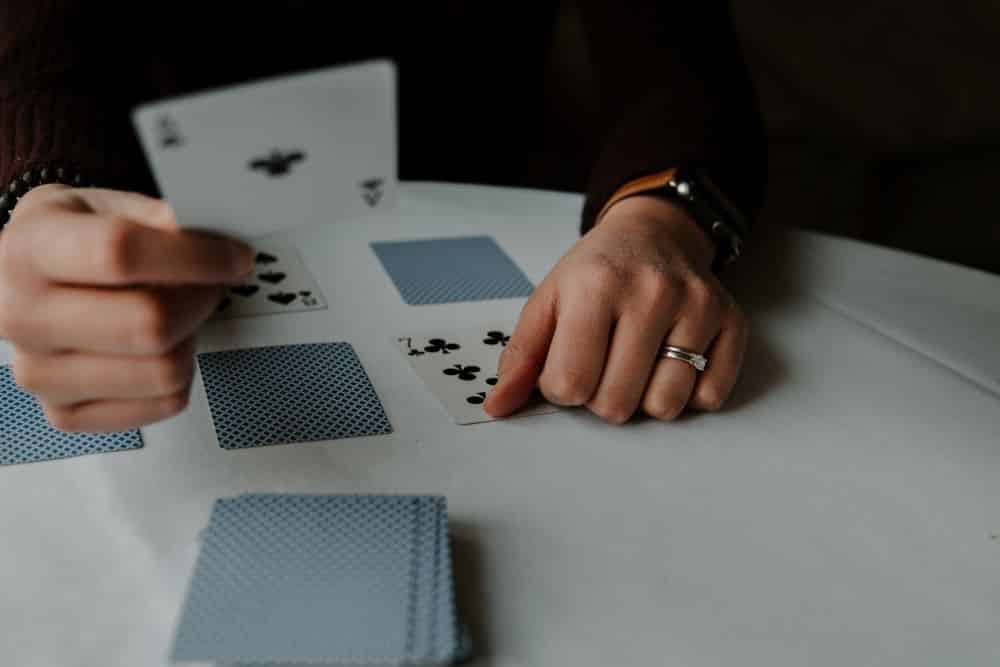
Another benefit to card games for kids is the flexibility in ways to play and improve different aspects of their education.
Often teachers use repetition to practice numbers, addition, subtraction, and multiplication. Practicing with quick on-the-spot mathematics can be a great way to strengthen your child’s learning and improve their skills.
Although not all mathematics requires speedy recall, you can use some of these card games for kids to improve their skills whilst playing a hilarious game! Let’s take a closer look at some of our favorite fast-paced classic card games.
1) Snip Snap Snorem
- Ages 7+
- Three or More Players
This classic card game is highly popular with kids and has several variants across the world known as Jig, Niggy-Noddy, and Schnipp-Schnapp-Schnurr-Burr-Basilorum in Germany!
You need a minimum of three players to enjoy this game and the aim is to have no remaining cards from your entire deck by the end of the game.
Your kids will love shouting pass, snip, snap and snorem as this fun, fast-paced card game continues!
How to Play Snip Snap Snorem
- Deal out all the cards, the first player is to the left of the dealer.
- The first person plays a card face up, then all other players have to match the rank in suits.
- If any other players don’t have a card to contribute they say “pass”.
- The person who plays the fourth card gets to choose any card from their hand for the next round.
- The appeal of this game for children is that they get to shout snip for the second card, snap for the third, and snorem for the last card!
- A player wins by making sure they have no cards left in their hand.
2) Beggar My Neighbor
- Ages 7+
- Two Players
This game is similar to Slapjack and doesn’t require any decisions to be made by the players. Whichever player has all of the cards wins and it’s important that cards are kept face down.
How to Play Beggar My Neighbor
- Deal out all the cards face down evenly in front of each player
- Player one turns over their top card if it is a number their turn ends but if it’s a face or ace then the player pays and “honors” by turning over cards based on the “Court Card” rules below.
- If all the honored cards are numbered, player one keeps the bunch. If a face card is turned over whilst paying the honor, the next player pays a fresh honor to player two.
- Keep playing until one person has all the cards and wins!
“Court Card” rules are as follows:
- If an Ace is played then the next player must turn over four cards face up, one at a time.
- If a King is played, then the next player must turn over three cards one at a time.
- If a Queen is played then the next player must turn over two cards.
- If a Jack is played the next player must turn over one card.
- If the card played has a rank of 2-10 then play passes to the left and the next player must do the same.
3) Old Maid
- Ages 4-10
- Two to Twelve Players
Old Maid has been a popular game for kids since the 1880s and can still provide great entertainment on long journeys and at home for your whole family!
It focuses on children’s pairing and recognition skills and can be played with any standard deck or even a specifically designed old maid deck.
It can help your children learn quantity recognition, matching and sorting mathematical abilities as well as social skills! Children who play Old Maid can learn from a young age the importance of good sportsmanship and how to to take turns to get the best fun from your laying experience.
It is easy to play and the perfect game to play when you’re not sure how to entertain the whole family. You remove one of the four queens, leaving a total of 51 remaining cards, and the goal is to form and discard pairs of cards and not to be left with the odd card (queen) at the end of the game.
Any player can shuffle the pack and deal them around until all the cards have been handed out. Players don’t need to have an equal number of cards.
If any old maid players are found to have discarded two cards that are not a pair of the same number or similar, then they automatically lose making them the Old Maid!’
How to Play Old Maid
- Once all cards have been handed out, each player removes all the pairs from their hand and puts them face down. If any player has three-of-a-kind they only remove two of the three cards.
- The dealer offers their hand, face down to the dealer’s left who is allowed to draw one card. This player discards any pairs that may have formed from this pick.
- This player now offers their hand face down to the player on their left. Play continues until all the cards have been paired except for the odd queen who cannot be paired.
- The player with the odd card at the end is the Old Maid!
5 Classic Kid-Friendly Card Games
View in gallery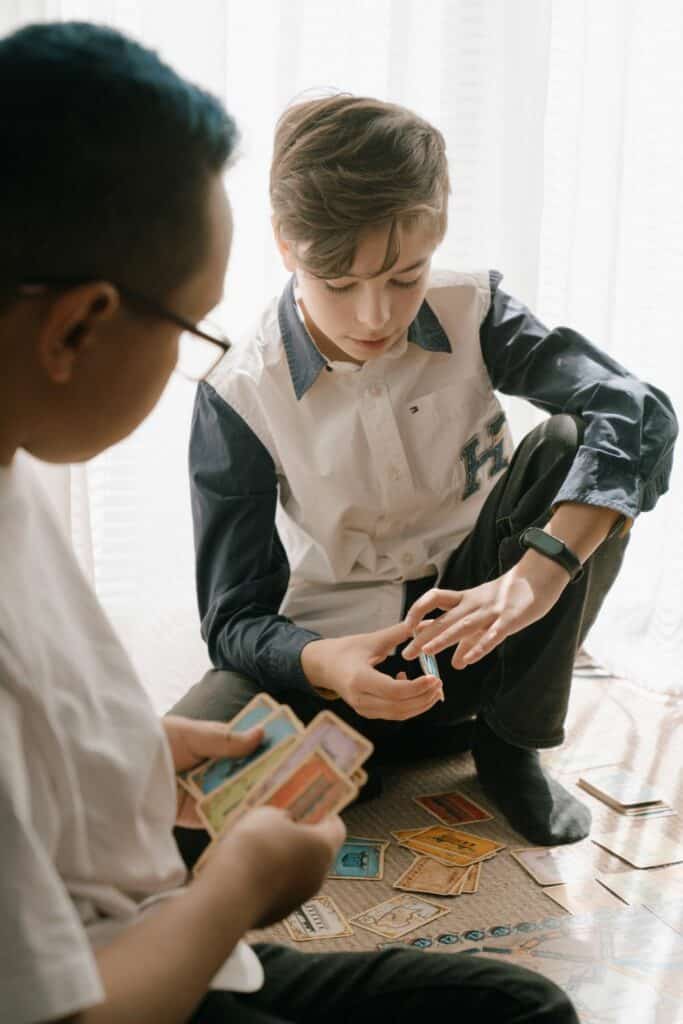
There are a wealth of card games that are suitable for children and many have been around for decades. Here are some of our favorite classic card games that will make family time away from a flickering screen lots more appealing and fun to your kids.
1) Go Fish
- Age 7+
- Two plus players
Go Fish is a card game that has been around for decades and yet is still a popular option when it comes to introducing card games to children. It helps children to learn thinking skills as well as recognize numbers as well as social skills.
How to Play Go Fish
Firstly you need to pick one player to be the dealer and they hand out the cards. Depending on how many players there are, each player gets dealt seven cards. If there are more than 2/3 players then each player only gets five cards each. The remaining cards in the pack are placed face down in a pile in the center – this is the fish pond.
Now each player needs to sort their cards into groups. This can be the same suit or number – a group of kings or groups of fours. Make sure that you do not show any other players your cards. You are now ready to begin playing.
The player to the left of the dealer starts by asking another player for a suit or number cards that will match any that they have. For example, they could ask for kings if they have two kings. If the other player has kings they then have to give these to the player that asked. But if they do not have any of the cards requested then, they then say ‘go fish’ to the other player and they then have to pick up one card from the fish pond (cards in the center). The player who was asked then becomes the next player to request a card from another player.
Once a player collects all four cards in a set – four queens or four nines, they put them face down in front of them. The winner is the first player to have no single cards left only complete sets.
2) Crazy Eights
- Age 5+
- 2 to 4 players
A great game for younger players that will help with thinking skills, number recognition, and shapes in regard to the suits of the cards – heart, diamond, etc.
How to Play Crazy Eights
If you are playing with two players each person gets dealt seven cards. If you have four players each player gets five cards dealt to them. The remainder of the pack is placed face down in the center with the top card turned over next to it – this is called the discard pile.
To start to play the player to the left of the dealer places a card from their hand that matches the number or the suit of the card in the discard pile that is face up. An example of this is if the card is a ten of spades then they could play any spade or any ten. If they do not have a matching card, they continue to pick up cards from the deck until they have one that is playable. Eights are wild cards and can be played with any suit. The tricky part is for the next player after an eight is played as they must match the number or suit that the eight card was meant to cover.
The winner is the first player to get rid of all their cards. If the deck runs out before there is a winner, the discard pile can be reused to continue the game until there is a winner.
3) War
- Age 6+
- Two players
How to Play War
Deal the full deck between the two players ensuring that the cards remain face down. Without looking at the cards players turn over one card at the same time and place it on the table – the player with the higher number wins both cards.
If both cards are the same then it is ‘war’. This is when players deal three cards face down plus one card face up. Now the player with the highest number takes all ten cards. This continues until one player is out of cards – the winner is the player with the cards left.
4) Uno
- Age 7+
- 2 to 10 players
How to Play Uno
For this game, you will need Uno cards which are not a standard card pack. Begin by shuffling all cards, then deal each player seven cards -these need to be kept face down. Put the remaining cards in the center of the table. This pile will make the draw pile where players will take from during the game. Turn the top card of the draw pile over to start the game.
The player to the left of the dealer needs to play a card that matches the color, number, word, or symbol on the card that faces up in the center. Then the next player takes their turn. If at any time a player can not match a card then they have to take another card from the draw pile.
In addition to the basic Uno cards, there are also wild cards and three action cards in a pack. If you play a wild card then you get to choose the color of the card for the next player. Here are the rules for the action cards:
- A reverse card has 2 arrows going in opposite directions and this means that the play changes direction and the person who went before you has to take another turn.
- A skip card is a card that has a circle with a slash through it and means the player next to you must skip their turn.
- A draw 2 card means that the player next to you must pick up two cards and skip their turn.
You keep playing until 1 player has just 1 card left. This is where that player must say UNO – if they do not say it they will be penalized if another player calls them out. The penalty is that they have to take 2 cards.
Once you are down to one card and you’ve called UNO all you need to do to win is play that final card.
5) Basic Blackjack
- Age 6+
- 2 to 10 players
There are a wealth of variations of this game but for children, you want to stick to a simple version. It is a great way for children to learn quick addition and subtraction.
How to Play Basic Blackjack
The aim of this game is to get cards that add up to 21. Here is how cards are valued:
- Aces are worth 1 or 11 points.
- Jacks, Queens, and Kings are worth 10 points.
- Other cards are worth the number stated on the card.
First of all, you need to shuffle the cards well and then deal 2 cards to each player. Each player then needs to look at their hand and decide if they want to stick (which means they don’t want any more cards) or they can decide that they want another card. Players can keep asking for another card for as long as they wish. But if at any time the value of their cards goes over 21 they immediately lose.
At the end, after all the players have decided to stick, they much each show their hand. The winner is the player whose cards add up to the closest to 21.
Tips for Playing Card Games with Children
View in gallery
From the age of just three, you can include your children in card games in order to introduce logical and strategical thinking and pass hours of time without the use of a screen!
Use Fewer Cards
When first introducing card games to your children you may find it’s easier to use fewer cards to keep it simple until the rules are better understood. Once you feel like your children have a better understanding of how the game works, then you can introduce longer playing times and a full deck of cards.
Simplify Decks/Use Thematic Decks
Create a highly appealing draw pile or satisfying same suit layouts with a visually appealing deck! There is a large variety available and can be themed to anything your child is interested in.
There may be one card your child struggles to learn, they may have difficulty passing cards when asked or picking up detailed instruction. So simplifying decks can be a great step towards helping them learn the difference in the same rank or just creating an easier play.
Avoid Arguments
A key to enabling simple games is to keep things black and white so all other games can run smoothly. Deciding who goes first and if players race to win, or can take their time helps your children understand the concepts of each play and know what to expect in play. This is key to avoiding arguments and keeping everything fair.
Repeat Rules
Making sure the rules of the game are understood and running practice rounds is a good way to help your kids stockpile everything they need to know when playing. Before each game starts, talking over the rules can help to familiarise your kids with what to expect.
Kids Card Games: Frequently Asked Questions
If you’re looking for quick answers to any questions related to your children’s card play then we have the answers!
What card games can a five-year-old play?
We’ve included some great games in this article that your five-year-old can join in too! Some popular choices are games such as snap and pairs wins as they are highly adaptable and you can tailor them to your children’s interests and taste.
How do you make card games appealing to kids?
Another great tip to encourage your children to get more involved with cards is to get them to help you make your own set! They can help you decorate and cut out colorful cards and make your own set that will look gorgeous whether it’s in a face-down pile or face-up!
Another great way is to introduce all the commonly used terms when playing with cards to avoid confusion making them feel unattracted to the idea of play.
Make sure you always have one player who is old enough to understand the gameplay and this player draws to help make sure every player is following the rules.
How do you win a game of Old Maid?
You can win a game of old maid by having the most same suit pairs at the end of the game, or a player loses by being left with the old maid as the top card in their hand!
What happens when you run out of cards in Old Maid?
When all players have run out of cards, the person holding the odd card of whichever suit you chose is the winning player. Make sure you deal out all the cards face down at the start of play.
What is an easy game to play with cards?
Games that are highly versatile and easy to play such as ones involving memory matching and mathematics are easy to play and can involve as many players as you want.
You can also use as little as three cards right up to all the cards to further increase or decrease the difficulty.
Card Games for Kids: Summary
Whether you’re the first person to introduce card games for kids into your family or have a long history of proud player wins, you can guarantee that there is a play option in this article that will be fun for the whole family and can even provide an educational experience.
Easy card games don’t need to be boring and some of the top card games are the basic ones with your own special twist! Making these memories together will create a lifelong love for card play.
We hope this article has given you some great ideas on how to involve the whole family in card games from the oldest to the youngest. Let us know in the comments if you have any tried and tested suggestions we may have missed out on, and tell us why you love them!

